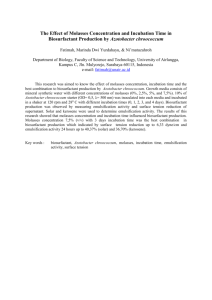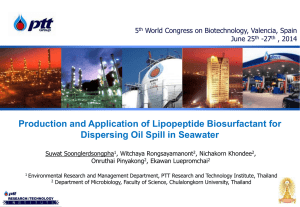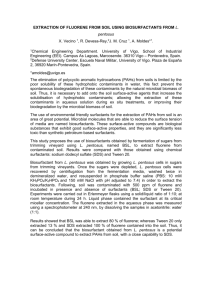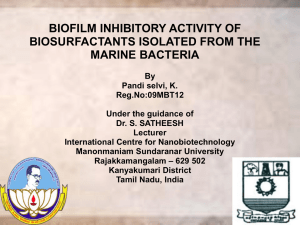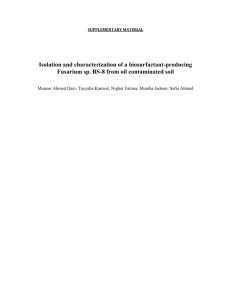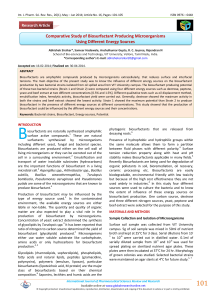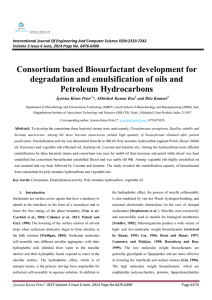Current Research Journal of Biological Sciences 6(2): 89-95, 2014
advertisement
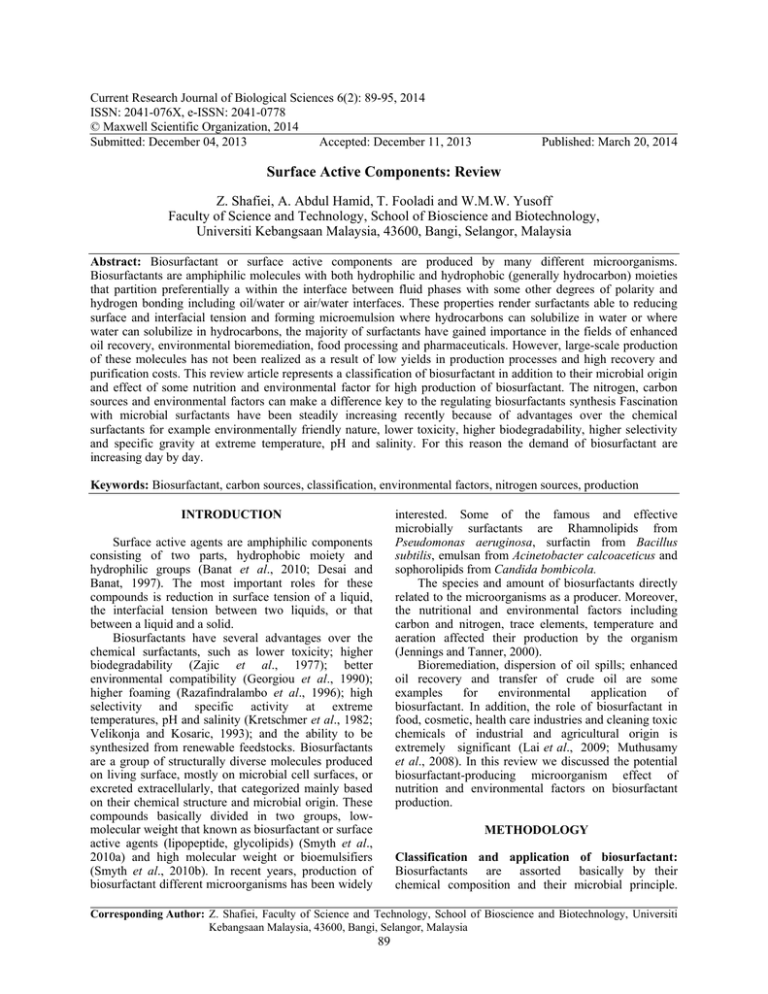
Current Research Journal of Biological Sciences 6(2): 89-95, 2014 ISSN: 2041-076X, e-ISSN: 2041-0778 © Maxwell Scientific Organization, 2014 Submitted: December 04, 2013 Accepted: December 11, 2013 Published: March 20, 2014 Surface Active Components: Review Z. Shafiei, A. Abdul Hamid, T. Fooladi and W.M.W. Yusoff Faculty of Science and Technology, School of Bioscience and Biotechnology, Universiti Kebangsaan Malaysia, 43600, Bangi, Selangor, Malaysia Abstract: Biosurfactant or surface active components are produced by many different microorganisms. Biosurfactants are amphiphilic molecules with both hydrophilic and hydrophobic (generally hydrocarbon) moieties that partition preferentially a within the interface between fluid phases with some other degrees of polarity and hydrogen bonding including oil/water or air/water interfaces. These properties render surfactants able to reducing surface and interfacial tension and forming microemulsion where hydrocarbons can solubilize in water or where water can solubilize in hydrocarbons, the majority of surfactants have gained importance in the fields of enhanced oil recovery, environmental bioremediation, food processing and pharmaceuticals. However, large-scale production of these molecules has not been realized as a result of low yields in production processes and high recovery and purification costs. This review article represents a classification of biosurfactant in addition to their microbial origin and effect of some nutrition and environmental factor for high production of biosurfactant. The nitrogen, carbon sources and environmental factors can make a difference key to the regulating biosurfactants synthesis Fascination with microbial surfactants have been steadily increasing recently because of advantages over the chemical surfactants for example environmentally friendly nature, lower toxicity, higher biodegradability, higher selectivity and specific gravity at extreme temperature, pH and salinity. For this reason the demand of biosurfactant are increasing day by day. Keywords: Biosurfactant, carbon sources, classification, environmental factors, nitrogen sources, production interested. Some of the famous and effective microbially surfactants are Rhamnolipids from Pseudomonas aeruginosa, surfactin from Bacillus subtilis, emulsan from Acinetobacter calcoaceticus and sophorolipids from Candida bombicola. The species and amount of biosurfactants directly related to the microorganisms as a producer. Moreover, the nutritional and environmental factors including carbon and nitrogen, trace elements, temperature and aeration affected their production by the organism (Jennings and Tanner, 2000). Bioremediation, dispersion of oil spills; enhanced oil recovery and transfer of crude oil are some examples for environmental application of biosurfactant. In addition, the role of biosurfactant in food, cosmetic, health care industries and cleaning toxic chemicals of industrial and agricultural origin is extremely significant (Lai et al., 2009; Muthusamy et al., 2008). In this review we discussed the potential biosurfactant-producing microorganism effect of nutrition and environmental factors on biosurfactant production. INTRODUCTION Surface active agents are amphiphilic components consisting of two parts, hydrophobic moiety and hydrophilic groups (Banat et al., 2010; Desai and Banat, 1997). The most important roles for these compounds is reduction in surface tension of a liquid, the interfacial tension between two liquids, or that between a liquid and a solid. Biosurfactants have several advantages over the chemical surfactants, such as lower toxicity; higher biodegradability (Zajic et al., 1977); better environmental compatibility (Georgiou et al., 1990); higher foaming (Razafindralambo et al., 1996); high selectivity and specific activity at extreme temperatures, pH and salinity (Kretschmer et al., 1982; Velikonja and Kosaric, 1993); and the ability to be synthesized from renewable feedstocks. Biosurfactants are a group of structurally diverse molecules produced on living surface, mostly on microbial cell surfaces, or excreted extracellularly, that categorized mainly based on their chemical structure and microbial origin. These compounds basically divided in two groups, lowmolecular weight that known as biosurfactant or surface active agents (lipopeptide, glycolipids) (Smyth et al., 2010a) and high molecular weight or bioemulsifiers (Smyth et al., 2010b). In recent years, production of biosurfactant different microorganisms has been widely METHODOLOGY Classification and application of biosurfactant: Biosurfactants are assorted basically by their chemical composition and their microbial principle. Corresponding Author: Z. Shafiei, Faculty of Science and Technology, School of Bioscience and Biotechnology, Universiti Kebangsaan Malaysia, 43600, Bangi, Selangor, Malaysia 89 Curr. Res. J. Biol. Sci., 6(2): 89-95, 2014 Table 1: Microbial source and properties of important types of microbial surfactants Biosurfactant groups Biosurfactant class Organisms Glycolipid Rhamnolipids P. aeruginosa Pseudomonas sp. Trehalolipids R. erythropolis N. erythropolis Sophorolipids Mycobacterium sp. T. bombicola Cellobiolipids T. apicola T. petrophilum U. zeae, U. maydis Lipopeptides and lipoproteins Peptide-lipid B. licheniformis Serrawettin S. marcescens Viscosin P. fluorescens Surfactin B. subtilis Subtilisin B. subtilis Gramicidins B. brevis Polymyxins B. polymyxa Fatty acids, neutral lipids and Fatty acids C. lepus phospholipids Neutral lipids N. erythropolis Phospholipids T. thiooxidans Polymeric surfactants Emulsan A. calcoaceticus Biodispersan A. calcoaceticus Mannan-lipid-protein C. tropicalis Liposan C. lipolytica Carbohydrate-protein-lipid P. fluorescens Protein PA D. polymorphis P. aeruginosa Particular biosurfactants Vesicles and fimbriae A. calcoaceticus Whole cell Variety of bacteria Biosurfactants categorized based on their chemical structure including glycolipids, lipopiptides, lipoprotein, phospholipids, natural lipids, polymeric surfactin, particular biosurfactants and fatty acid (Levy et al., 1990; Soberón-Chávez and Maier, 2011). Biosurfactant sorted in 2 groups based on molecular weight, low-molecular-mass molecules, which efficiency lower surface and interfacial tension and high-molecular-mass polymers, which are more impressive as emulsion stabilizing oil-in-water (Herman and Maier, 2002). Based on molecular weight they are divided into low-molecular-mass molecules, which efficiency lower surface and interfacial tension and high-molecular-mass polymers, which are more effective as emulsion stabilizing oil-in-water (Herman and Maier, 2002). Low-molecular-mass biosurfactants including glycolipids, phospholipids and lipopeptides and the major classes of high-mass surfactants containing amphipathic polysaccharides, proteins, lipopolysaccharides, lipoproteins or complex mixtures of these biopolymers (Rosenberg and Ron, 1999; Calvo et al., 2009). The major biosurfactant classes and their producers are depicted in Table 1. All surfactants are chemically synthesized. However, wide range of functional properties and various synthetic capabilities of microorganisms caused to more consideration for biosurfactant during the last decades. Compare to the chemical surfactants, biosurfactants have specific properties including environmental compatibility for their easily biodegradability and low toxicity. These advantages of microbially surfactants allow them to be an appropriate replacement of chemically synthesized surfactants in a large number of industrial operations. Surface tension (m N/m) 29 25-30 32-36 30 38 33 30 27 28-33 26.5 27-32 30 32 27 In addition, they are ecologically safe and can be applied in bioremediation and wastewater treatment (Cotter et al., 2005). Some of the potential applications of biosurfactants in pollution and environmental control are microbial enhanced oil recovery, hydrocarbon degradation in soil environment and hexa-chloro cyclohexane degradation, heavy metal removal from contaminated soil and hydrocarbon in aquatic environment (Kosaric, 1992; Nerurkar et al., 2009; Sifour et al., 2007). The potential roles and applications of biosurfactants, mainly focusing on areas such as food and food-related industries, biomedicine and therapeutics is given in Table 2. Microorganisms: Biosurfactant are produced by a variety of prokaryotes and eukaryotes. Microorganisms utilize a variety of organic compounds as the source of carbon and energy for their growth. Biosurfactant production by microorganisms is growth dependence. Desai and Desai (1993) studied on production of biodispersan by A. calcoaceticus as a manifest sample for growth associated biosurfactant production. Moreover, growth limitation condition may possibly cause to production or (motivation) of biosurfactant by microbial cells. Over production of rhamnolipid by P. aeruginosa occur when the culture attains the stationary growth phase because of the nitrogen source restriction. Velraeds et al. (1996) reported that production of biosurfactant by Lactobacilli in the stationary phase is optimal for cell. During the fermentation process, a direct relevance exists between biosurfactant production and cell growth. 90 Curr. Res. J. Biol. Sci., 6(2): 89-95, 2014 Table 2: Industrial applications of biosurfactants Industry Application Petroleum Enhanced oil recovery Environmental Food De-emulsification Bioremediation Soil remediation and flushing Biological Emulsification and deemulsification Functional ingredient Microbiological Agricultural Pharmaceuticals and therapeutics Biocontrol Bioprocessing Downstream processing Cosmetic Health and beauty products Role of biosurfactants Improving oil drainage into well bore, stimulating release of oil entrapped by capillaries, wetting of solid surfaces, reduction of oil viscosity and oil pour point, lowering of interfacial tension, dissolving of oil De-emulsification of oil emulsions, oil solubilization, viscosity reduction, wetting agent Emulsification of hydrocarbons, lowering of interfacial tension, metal sequestration Emulsification through adherence to hydrocarbons, dispersion, foaming agent, detergent, soil flushing Emulsifier, solubilizer, demulsifier, suspension, wetting, foaming, defoaming, thickener, lubricating agent Interaction with lipids, proteins and carbohydrates, protecting agent Physiological behavior such as cell mobility, cell communication, nutrient accession, cellcell competition, plant and animal pathogenesis Antibacterial, antifungal, antiviral agents, adhesive agents, immunomodulatory molecules, vaccines, gene therapy Facilitation of biocontrol mechanisms of microbes such as parasitism, antibiosis, competition, induced systemic resistance and hypovirulence Biocatalysis in aqueous two-phase systems and microemulsions, biotransformations, recovery of intracellular products, enhanced production of extracellular enzymes and fermentation products Emulsifiers, foaming agents, solubilizers, wetting agents, cleansers, antimicrobial agents, mediators of enzyme action Factors affecting biosurfactant production: Surface active agents or biosurfactant are amphiphilic compounds. They consist a hydrophobic and hydrophilic section. Carbohydrate, an amino acid and phosphate group can be as a hydrophilic head and frequently long-carbon-chain fatty acid is a hydrophobic tail. Biosurfactants are produced by a number of microorganisms, predominantly during their growth on water-immiscible substrates. However, some yeast may produce biosurfactants in the presence of different types of substrates, such as carbohydrates. There are several reports on optimization of physicochemical properties for biosurfactant production (Sarubbo et al., 2006, 2001). The nitrogen source plays significant role in the regulation of biosurfactants synthesis. Arthobacter paraffineus ATCC 19558 used ammonium to nitrate as an inorganic nitrogen source for biosurfactants production. A change in the growth rate of the concerned microorganisms is mostly adequate to result in higher production of biosurfactants (Kretschmer et al., 1982). In some cases, pH and temperature regulate biosurfactants synthesis. For example in rhamnolipid production by Pseudomonas sp., in cellobioselipid formation by Ustilago maydis pH can be an important key (Frautz et al., 1986) and in the case of Arthrobacter paraffineus ATCC 19558 temperature was important (Duvnjak et al., 1982). and olive oil (Robert et al., 1989; Syldatk et al., 1985; Yamaguchi et al., 1976) was not an appropriate substrate to obtain the desirable biosurfactant product. Zinjarde and Pant (2002) reported the synthesis of surfactant by Y. lipolytica NCIM 3589 using soluble carbon source such as glucose, glycerol and sodium acetate. Study on Biosurfactant production by B. subtilis MTCC 2423 demonstrated the higher reduction in surface tension of cell-free broth when glucose, sucrose, tri sodium citrate, sodium pyruvate, yeast extract and beef extract used as carbon sources. The other investigation on mannan-proteins production by Kluyveromyces marxianus Lukondeh et al. (2003) showed the better reduction in surface tension when Lactose has also been used as soluble substrate. Although different carbon sources in the medium affected the composition of biosurfactant production in Pseudomonas sp., substrates with different chain lengths exhibited no effect on the chain length of fatty acid moieties in glycolipids (Syldatk et al., 1985). All studies on biosurfactant demonstrated that the available carbon source, particularly the carbohydrate used, extremely effect on the type of biosurfactant produced (Itoh and Suzuki, 1974; Li et al., 1984; Suzuki et al., 1974). On the other hand, the mentioned C-sources, such as glucose, glycerol, acetates and other organic acids, as well as pure n-alkanes are expensive and cannot reduce the cost of biosurfactant production. Approximately, reduction the cost is partial or complete replacement of pure reagents with industrial/agricultural mixtures. Carbon source: The carbon sources have a significant role in biosurfactant production. These sources are divided into three categories of carbohydrate, hydrocarbon and vegetable oil which all are used in bacterial culture and biosurfacnat production. The Pseudomonas spp. mostly used glycerol, glucose, mannitol and ethanol as Water-soluble carbon sources for production of rhamnolipid. Whereas, some of the water-immiscible substrates such as n-alkanes Nitrogen source: Whereas nitrogen is a substantial component of the protein structure, this element plays an important role in biosurfactant production because proteins are necessary compounds for the growth of microbes and for production of enzymes in the fermentation process. Various microorganisms used 91 Curr. Res. J. Biol. Sci., 6(2): 89-95, 2014 different kind of nitrogen sources. For example, ammonium salts and urea were preferred nitrogen sources for biosurfactant production by Arthrobacter paraffineus, whereas nitrate supported maximum surfactant production by Pseudomonas aeruginosa (Guerra-Santos et al., 1986) and Rhodococcus sp., (Abu-Rawaida et al., 1991a). Biosurfactant production increased in Pseudomonas aeruginosa (Ramana and Karanth, 1989), Candida tropicalis IIP-4 (Singh et al., 1990) and Nocardia strain SFC-D (Kosaric et al., 1990) due to the nitrogen limitation. Similarly Abu-Ruwaida et al. (1991a) indicated that the best source of nitrogen for biosurfactant production was nitrate when Pseudomonas strain 44T1 and Rhodococcus strain ST-5 growing on olive oil and paraffin, respectively. Maximum rhamnolipid production by Pseudomonas aeruginosa obtained in nitrogen limitation at a C: N ratio of 16:1 to 18:1, whereas, surfactant production did not observe at a C: N ratio below of 11:1, where the culture was not nitrogen limited. According to Hommel et al. (1987), it is the total quantity of nitrogen and not its comparative concentration that emerges to be important for optimal biomass yield, while the concentration of hydrophobic carbon source defined the variation of carbon available to the biosurfactant. biosurfactant at temperature above 40°C. The other exciting reports on heat treatment of biosurfactants showed that the properties of some biosurfactants, such as the lowering of surface tension and interfacial tension and the emulsification efficiency, has not change after autoclaving at 120°C for 15 min (AbuRawaida et al., 1991b). Deshpande and Daniels (1995) considered that the maximum temperature for growth of C. bombicola is at 30°C while 27°C is the best temperature for the production of sophorolipids. Reduction of biosurfactant yield occurred when agitation speed increased and it is due to the effect of shear in Nocardia erythropolis (Margaritis et al., 1979). Adamczak and Bednarski (2000) reported the effect of aeration in the biosurfactant production by C. antarctica and demonstrated that the maximum production (45.5 g/L) is achieved when air flow rate is 1 vvm and the dissolved oxygen concentration is maintained at 50% of saturation. However, changing the air flow rate to 2 vvm, there is a high foam formation and the biosurfactant production decreases up to 84% (Guilmanov et al., 2002). Production of some biosurfactants strongly affected by metal ions concentrations because they form important cofactors of many enzymes. The overproduction of surfactin biosurfactant occurs in presence of Fe2+ in the mineral salt medium. The properties of surfactin are improved in the presence of inorganic cations such as overproduction (Thimon et al., 1992). Salt concentration plays important roles on biosurfactant production depending on its effect on cellular activity. Some biosurfactant products, however, were not affected by salt concentrations up to 10% (w/v), although little reduction in the critical micelle concentrations was demonstrated (Abu-Rawaida et al., 1991b). Environmental factors: The yield and characteristics of the biosurfactant produced are strongly affected by environmental factors. In order to increase the quantity of biosurfactant it is required to optimize the process conditions because some mutable factors such as pH, temperature, aeration, agitation speed and oxygen availability effect on cellular growth, activity and biosurfactant production. The pH of the medium is an extremely significant factor that plays an important role in sophorolipid production. The Pseudomonas sp., Produced rhamnolipid at its maximum level at a pH range from 6 to 6.5 and decrease quickly when pH increase up to 7 (Guerra-Santos et al., 1984). Zinjarde and Pant (2002) reported the effect of the initial pH in the production of a biosurfactant by Y. lipolytica. The maximum biosurfactant production obtained at pH 8.0 which is the natural pH of sea water. The other important parameter is the acidity of the culture condition on production of glycolipids by C. antarctica and C. apicola. In this study the maximum production of glycolipids reported at pH 5.5. Production of the biosurfactant decreased without the pH control displaying. So, it shows the importance of maintaining it during the fermentation process (Bednarski et al., 2004). Most of the biosurfactant productions indicated so far have been carried out in a temperature range of 25 to 30°C (Casas and Garcia-Ochoa, 1999). A thermophilic Bacillus sp., grew and produced CONCLUSION The successful commercialization of every biotechnological product depends largely on its Bioprocess economics. These compounds do not compete economically with synthetic surfactants. The cost of chemical biosurfactant is about 3-10 times less than that of the Synthetic peers (Mulligan and Gibbs, 1993). The fermentation process and chooses of inexpensive row materials are effective factors to modifying the overall processing economics in biosurfacatnt production. Commonly, hydrocarbons used for production of biosurfactant which are generally expensive, so it caused to increase the overall process cost. However, other cheaper, water-soluble substrates such as glucose (Hommel et al., 1994; Stuwer et al., 1987) and ethanol (Mulligan and Gibbs, 1989; Palejwala and Desai, 1989) are sometimes used. 92 Curr. Res. J. Biol. Sci., 6(2): 89-95, 2014 In the search for cheaper raw materials for biosurfactant production, industrial effluents have recently shown good promise. In the present review, we have shown a complete survey of several means to make biosurfactants economical. In the recent years, so many investigations have done on the process of biosurfactant fermentation by many microorganisms. Focus on interdisciplinary research corporate with technologies of large-scale fermentation and metabolic engineering, also according to the exciting new development in this field, biosurfactants will be commercially successful compounds of the future. Desai, J. and A. Desai, 1993. Production of Biosurfactants. In: Kosaric, N. (Ed.), Biosurfactants: Production, Properties and Applications. Marcel Dekker, New York, pp: 65-97. Desai, J.D. and I.M. Banat, 1997. Microbial production of surfactants and their commercial potential. Microbiol. Mol. Biol. R., 61: 47-64. Deshpande, M. and L. Daniels, 1995. Evaluation of sophorolipid biosurfactant production by Candida bombicola using animal fat. Bioresource Technol., 54: 143-150. Duvnjak, Z., D.G. Cooper and N. Kosaric, 1982. Production of surfactant by Arthrobacter paraffineus ATCC 19558. Biotechnol. Bioeng., 24: 165-175. Frautz, B., S. Lang and F. Wagner, 1986. Formation of cellobios lipids by growing and resting cells of Ustilago maydis. Biotechnol. Lett., 8: 757-762. Georgiou, G., S.C. Lin and M.M. Sharma, 1990. Surface-active compounds from microorganisms. Biotechnology, 10: 60-65. Guerra-Santos, L., O. Kappeli and A. Fiechter, 1984. Pseudomonas aeruginosa biosurfactant production in continuous culture with glucose as carbon source. Appl. Environ. Microbiol., 48: 301-305. Guerra-Santos, L., O. Kappeli and A. Fiechter, 1986. Dependence of Pseudomonas aeruginosa continuous culture biosurfactant production on nutritional and environmental factors. Appl. Microbiol. Biot., 24: 443-448. Guilmanov, V., A. Ballistreri and G. Impallomeni, 2002. Oxygen transfer rate and sophorose lipid production by Candida bombicola. Biotechnol. Bioeng., 77: 489-495. Herman, D.C. and R.M. Maier, 2002. Biosynthesis and Applications of Glycolipid and Lipopeptide Biosurfactants. In: Kuo, T.M. and H.W. Gardner (Eds.), Lipid Biotechnology. Marcel Dekker, New York, USA, pp: 629-654. Hommel, R.K., O. Stuwer, W. Stuber, D. Haferburg and H.P. Kleber, 1987. Production of water-soluble surface-active exolipids by Torulopsis apicola. Appl. Microbiol. Biot., 26: 199-205. Hommel, R.K., L. Weber, A. Weiss, U. Himelreich, O. Rilke and H.P. Kleber, 1994. Production of sophorose lipid by Candida (Torulopsis) apicola grown on glucose. J. Biotechnol., 33: 147-155. Itoh, S. and T. Suzuki, 1974. Fructose lipids of Arthrobacter, corynebacteria, nocardia and mycobacteria grown on fructose. Agr. Biol. Chem. Tokyo, 38: 1443-1449. Jennings, E.M. and R.S. Tanner, 2000. Biosurfactantproducing bacteria found in contaminated and uncontaminated soils. Proceedings of the 2000 Conference on Hazardous Waste Research, pp: 299-306. 5T 5T ACKNOWLEDGMENT Authors are grateful to Department of Science and Technology, School Bioscience and Biotechnology, National University of Malaysia (UKM), for providing necessary facilities for the execution of the present study. REFERENCES Abu-Ruwaida, A.S., I.M. Banat, S. Haditirto, A. Salem and M. Kadri, 1991a. Isolation of biosurfactantproducing bacteria product characterization and evaluation. Acta Biotechnol., 11: 315-324. Abu-Ruwaida, A.S., I.M. Banat, S. Haditirto, A. Salem and M. Kadri, 1991b. Isolation of biosurfactantproducing bacteria product characterization and evaluation. Acta Biotechnol., 11: 315-324. Adamczak, M. and W. Bednarski, 2000. Influence of medium composition and aeration on the synthesis of biosurfactants produced by Candida antarctica. Biotechnol. Lett., 22: 313-316. Banat, I.M., A. Franzetti, I. Gandolfi, G. Bestetti, M.G. Martinotti, L. Fracchia, T.J. Smyth and R. Marchant, 2010. Microbial biosurfactants production, applications and future potential. Appl. Microb. Biotechnol., 87(2): 427-444. Bednarski, W., M. Adamczak and J. Tomasik, 2004. Application of oil refinery waste in the biosynthesis of glycolipids by yeast. Bioresource Technol., 95: 15-18. Calvo, C., M. Manzanera, G.A. Silva-Castro, I. Uad and J. González-López, 2009. Application of bioemulsifiers in soil oil bioremediation processes. Future prospects. Sci. Total Environ., 407: 3634-3640. Casas, J.A. and F. Garcia-Ochoa, 1999. Sophorolipid production by Candida bombicola medium composition and culture methods. J. Biosci. Bioeng., 88: 488-494. Cotter, P.D., C. Hill and R.P. Ross, 2005. Bacteriocins: Developing innate immunity for food. Nat. Rev. Microbiol., 3: 777-788. 93 Curr. Res. J. Biol. Sci., 6(2): 89-95, 2014 Kosaric, N., 1992. Biosurfactants in industry. Pure Appl. Chem., 64: 1731-1737. Kosaric, N., H.Y. Choi and R. Bhaszczyk, 1990. Biosurfactant production from Nacardia SFC-D. Tenside Surfact. Det., 27: 294-297. Kretschmer, A., H. Bock and F. Wagner, 1982. Chemical and physical characterization of interfacial-active lipids from Rhodococcus erythropolis grown on n-alkanes. Appl. Environ. Microb., 44: 864-870. Lai, C.C., Y.C. Huang, Y.H. Wei and J.S. Chang, 2009. Biosurfactant-enhanced removal of total petroleum hydrocarbons from contaminated soil. J. Hazard. Mater., 167: 609-614. Levy, N., Y. Bar-Or and S. Magdassi, 1990. Flocculation of bentonite particles by a cyanobacterial bioflocculant. Colloid Surface., 48: 337-349. Li, Z.Y., S. Lang, F. Wagner, L. Witte and V. Wray, 1984. Formation and identification of interfacialactive glycolipids from resting microbial cells of Arthrobacter sp. and potential use in tertiary oil recovery. Appl. Environ. Microb., 48: 610-617. Lukondeh, T., N.J. Ashbolt and P.L. Rogers, 2003. Evaluation of kluyveromyces marxianus as a source of yeast autolysates. J. Ind. Microbiol. Biot., 30: 52-56. Margaritis, A., J.E. Zajic and D.F. Gerson, 1979. Production and surface-active properties of microbial surfactants. Biotechnol. Bioeng., 21: 1151-1162. Mulligan, C.N. and B.F. Gibbs, 1989. Correlation of nitrogen metabolism with biosurfactant production by Pseudomonas aeruginosa. Appl. Environ. Microb., 55: 3016-3019. Mulligan, C.N. and B.F. Gibbs, 1993. Factors Influencing the Economics of Biosurfactants. In: Kosaric, N. (Ed.), Biosurfactants: Production, Properties, Applications. Marcel Dekker Inc., New York, pp: 329-371. Muthusamy, K., S. Gopalakrishnan, T.K. Ravi and P. Sivachidambaram, 2008. Biosurfactants: Properties, commercial production and application. Curr. Sci., 94: 736-747. Nerurkar, A.S., K.S. Hingurao and H.G. Suthar, 2009. Bioemulsfiers from marine microorganisms. J. Sci. Ind. Res., 68: 273-277. Palejwala, S. and J.D. Desai, 1989. Production of extracellular emulsifier by a Gram negative bacterium. Biotechnol. Lett., 11: 115-118. Ramana, K.V. and N.G. Karanth, 1989. Factors affecting biosurfactant production using Pseudomonas aeruginosa CFTR-6 under submerged conditions. J. Chem. Technol. Biot., 45: 249-257. Razafindralambo, H., M. Paquot, A. Baniel, Y. Popineau, C. Hbid, P. Jacques and P. Thonart, 1996. Foaming properties of surfactin: A lipopeptide biosurfactant from Bacillus subtilis. J. Am. Oil Chem. Soc., 73: 149-151. Robert, M., M.E. Mercade, M.P. Bosch, J.L. Parra, M.J. Espuny, M.A. Manresa and J. Guinea, 1989. Effect of the carbon source on biosurfactant production by Pseudomonas aeruginosa 44T. Biotechnol. Lett., 11: 871-874. Rosenberg, E. and E.Z. Ron, 1999. High and lowmolecular-mass microbial surfactants. Appl. Microbiol. Biot., 52: 154-162. Sarubbo, L.A., M.C. Marcal and M.L.C. Neves, 2001. Bioemulsifier production in batch culture using glucose as carbon source by Candida lipolytica. Appl. Biochem. Biotech., 95: 59-67. Sarubbo, L.A., J.M. Luna and G.M. Campos-Takaki, 2006. Production and stability studies of the bioemulsifier obtained from a new strain of Candida glabrata UCP 1002. Electron. J. Biotechn., 9: 400-406. Sifour, M., M.H. Al-Jilawi and G.M. Aziz, 2007. Emulsification properties of biosurfactant produced from Pseudomonas aeruginosa RB 28. Pak. J. Biol. Sci., 10: 1331-1335. Singh, M., V.S. Saini, D.K. Adhikari, J.D. Desai and V.R. Sista, 1990. Production of bioemulsifier by producing strain of Candida tropicalis during hydrocarbon fermentation. Biotechnol. Lett., 12: 743-746. Smyth, T.J.P., A. Perfumo, S. McClean, R. Marchant and I.M. Banat, 2010a. Isolation and Analysis of Lipopeptides and High Molecular Weight Biosurfactants. In: Timmis, K.N. (Ed.), Handbook of Hydrocarbon and Lipid Microbiology. Springer, Berlin. Smyth, T.J.P., A. Perfumo, R. Marchant and I.M. Banat, 2010b. Isolation and Analysis of Low Molecular Weight Microbial Glycolipids. In: Timmis, K.N. (Ed.), Handbook of Hydrocarbon and Lipid Microbiology. Springer, Berlin. Soberón-Chávez, G. and R.M. Maier, 2011. Biosurfactants: A General Overview. In: SoberónChávez, G. (Ed.), Biosurfactants. Springer-Verlag, Berlin, Germany, pp: 1-11. Stuwer, O., R. Hommel, D. Haferburg and H.P. Kieber, 1987. Production of crystalline surface-active glycolipids by a strain of Torulopsis apicola. J. Biotechnol., 6: 259-269. Suzuki, T., H. Tanaka and S. Itoh, 1974. Sucrose lipids of Arthrobacteria, Corynebacteria and Nocardia grown on sucrose. Agr. Biol. Chem. Tokyo, 38: 557-563. 94 Curr. Res. J. Biol. Sci., 6(2): 89-95, 2014 Velraeds, M.M., H.C. VanderMei, G. Reid and H.J. Busscher, 1996. Physicochemical and biochemical characterization of biosurfactants released by Lactobacillus strains. Colloid Surface. B, 8: 51-61. Yamaguchi, M., A. Sato and A. Yukuyama, 1976. Microbial production of sugar lipids. Chem. Ind., 17: 741-742. Zajic, J.E., H. Gignard and D.F. Gerson, 1977. Properties and biodegradation of a bioemulsifier from Corynebacterium hydrocarboclastus. Biotechnol. Bioeng., 19: 1303-1320. Zinjarde, S.S. and A. Pant, 2002. Emulsifier from tropical marine yeast, Yarrowia lipolytica NCIM 3589. J. Basic Microb., 42: 67-73. Syldatk, C., S. Lang, U. Matulovic and F.Z. Wagner, 1985. Production of four interfacial active rhamnolipids from n-alkanes or glycerol by resting cells of Pseudomonas sp. DSM 2874. Z. Naturforsch, 40C: 61-67. Thimon, L., F. Peypoux and G. Michel, 1992. Interaction of surfactin: A biosurfactant from Bacillus subtilis, with inorganic cations. Biotechnol. Lett., 14: 713-718. Velikonja, J. and N. Kosaric, 1993. Biosurfactant in Food Applications. In: Kosaric, N. (Ed.), Biosurfactants: Production, Properties, Applications. Marcel Dekker Inc., New York, pp: 419-446. 95
